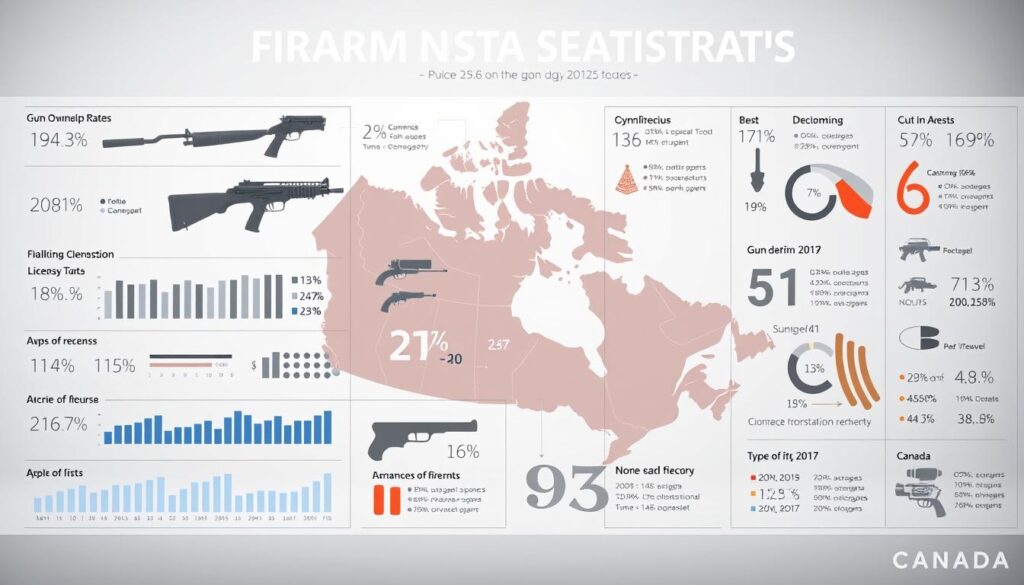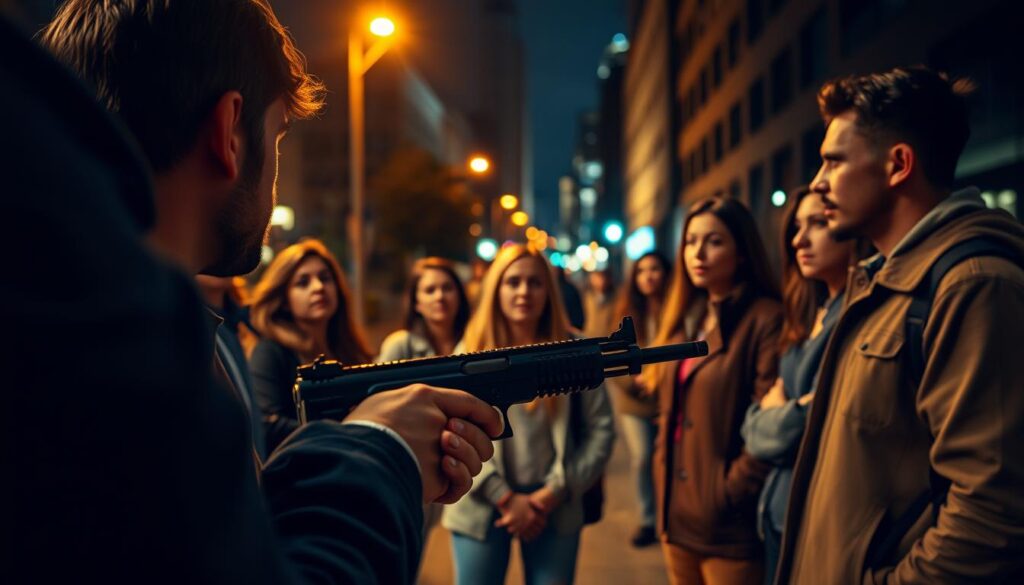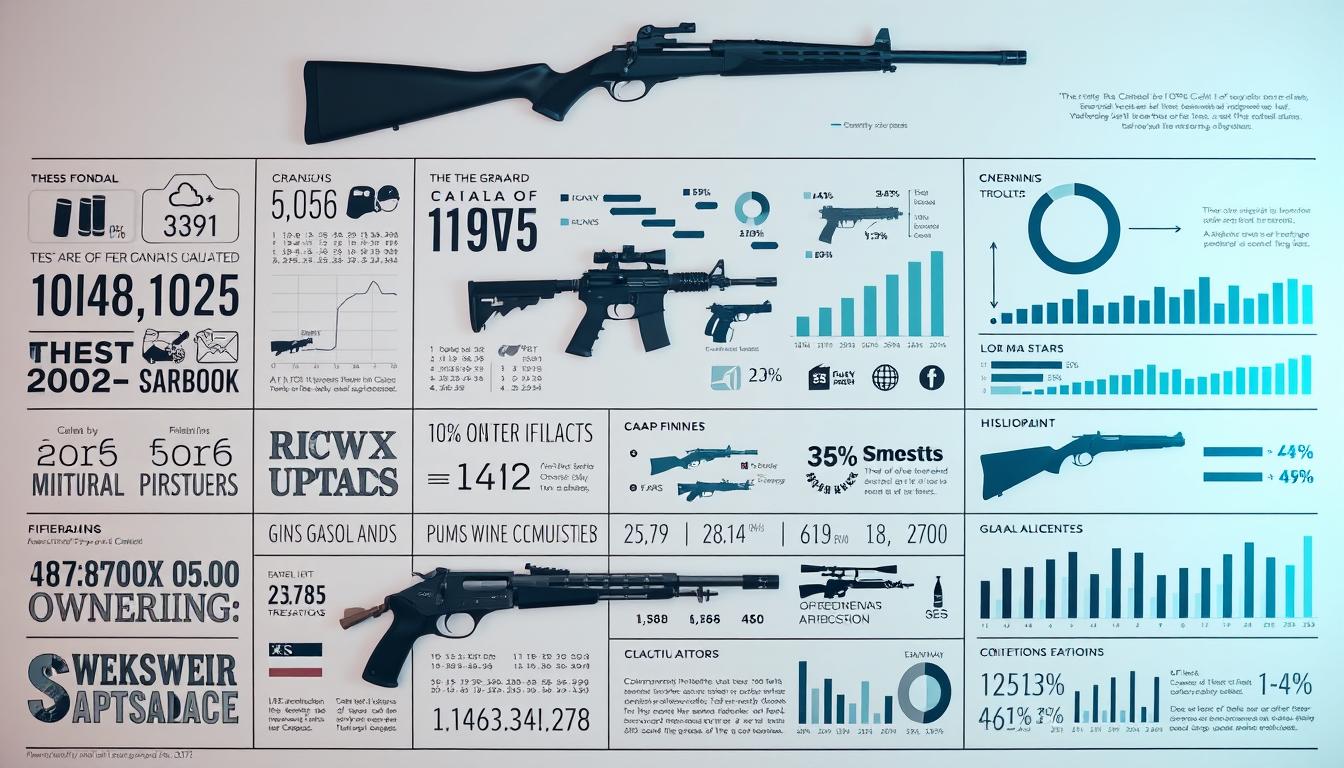Table of Contents
Canada’s firearm landscape includes over 2.2 million licensed owners, with an estimated 7 million legally owned firearms nationwide. While all restricted and prohibited firearms must be registered, most non-restricted long guns are not subject to federal registration requirements (except in Quebec, where provincial rules apply). This distinction helps explain why registration figures appear lower than overall ownership numbers. Understanding these statistics is crucial for informed debates on public safety, policy, and legal compliance.
The Small Arms Survey 2017 remains a useful historical benchmark, but more recent data provides updated insights. For example, approximately 1.2 million firearms are currently registered in the national system, and hundreds of thousands of licenses are renewed each year. These figures reflect both stability and change in patterns of ownership and governance.
This guide examines Canada’s firearm ecosystem through verified data, regional patterns, and international comparisons. It also outlines legal considerations such as license refusals, renewals, and provincial variations, to clarify responsibilities for owners. For individuals seeking legal guidance, specialized practitioners in firearms law can provide tailored advice.
Balancing transparency with privacy, the analysis avoids oversimplification while remaining accessible. Whether you are a policymaker, legal professional, or concerned citizen, this resource aims to bridge knowledge gaps in what is often a polarized conversation.
Overview of Firearm Ownership in Canada
Survey data reveals wide contrasts in household firearm possession across provinces and territories. A 2023 Angus Reid study found that 26% of Canadian households own at least one firearm. However, the national average masks dramatic regional differences.
Survey Insights: Urban vs. Rural Patterns
Ontario: 15% of households report ownership, with long guns making up about 94% of those firearms.
Yukon/Northwest Territories: 67% of households report ownership, reflecting strong hunting and cultural traditions. Restricted firearms account for about 18%.
Major Cities (e.g., Toronto, Vancouver, Montreal): Just 2.8% of households report ownership, with handguns making up 11% of firearms
Regional Ownership Dynamics
Rural areas account for 37.3% of firearm-owning households, largely linked to hunting and agricultural needs. Population density is a key factor—sparsely populated regions report ownership rates up to 24 times higher than metropolitan areas.
Survey limitations include potential underreporting in remote communities. The Department of Justice notes discrepancies between registered firearms and actual possession, underscoring the challenges of tracking ownership.
These statistics continue to shape public safety debates and regulatory approaches. By recognizing both national trends and regional realities, policymakers can better balance regulation with cultural and practical considerations.
How Many Guns Are in Canada: Detailed Statistics
Quantifying civilian-held firearms requires balancing registry data with statistical modeling. While official records show 1.2 million registered weapons, researchers estimate over 7 million privately owned firearms nationwide. This discrepancy stems from legacy registries and varied reporting requirements across provinces.

Analysis of Civilian Firearms Data
Recent analyses combine multiple sources:
- RCMP licensing records (2.35 million valid permits)
- Angus Reid Institute household surveys
- Retail sales projections
These methods suggest approximately 34.7 firearms per 100 residents, with unregistered weapons outnumbering documented ones 5:1. Regional variations remain significant—rural areas account for 63% of estimated holdings.
International Ownership Comparisons
Canada’s firearm density aligns closer to European nations than its southern neighbor:
| Country | Firearms per 100 People | Registered vs. Unregistered |
|---|---|---|
| United States | 120.5 | 0.3% registered |
| Finland | 32.4 | 86% registered |
| Canada | 34.7 | 16.4% registered |
As highlighted in the global firearm ownership rates study, cultural factors and regulatory frameworks shape these contrasts. Canada’s numbers reflect both recreational traditions and evolving policy priorities.
Legal professionals like Sohi Law Group emphasize how these statistics influence license approvals and compliance strategies. With 400,000+ license renewals processed annually, precise data interpretation remains critical for lawful ownership.

Legal Framework and Gun Control Policies
Canada’s firearm regulations combine federal oversight with provincial enforcement. The foundation lies in the Criminal Code and the Firearms Act, which classify weapons into non-restricted, restricted, and prohibited categories. To legally own firearms, individuals must complete safety training, pass background checks, and obtain a license through the RCMP-administered program.
Federal Laws and Regulations
Key elements include mandatory licensing for all firearm owners and strict storage rules. Background checks review criminal history, mental health records, and risks of domestic violence. Since 2020, the federal government has prohibited over 1,500 models of assault-style firearms.
Recent Legislative Changes
New measures aim to strengthen public safety:
- A national freeze on handgun sales since October 2022
- “Red flag” laws allowing courts to remove firearms during domestic disputes
- Temporary license suspensions for individuals posing safety risks
Penalties for trafficking and smuggling have also increased, with maximum sentences now reaching 14 years. These updates expand law enforcement’s ability to track firearms and prosecute offenders.
Measurement Challenges of Firearm Ownership
Determining precise firearm ownership statistics is difficult due to incomplete data and differing methodologies. While surveys provide useful insights, privacy concerns and underreporting limit their reliability. Household polls often miss unregistered or inherited firearms, or respondents reluctant to disclose ownership.
Survey Limitations and Estimation Techniques
Common approaches, such as Angus Reid Institute surveys, reveal key weaknesses:
- Exclusion of non-residential holdings (e.g., businesses, farms)
- Underreporting due to legal concerns or cultural stigma
- Inability to track firearms transferred through informal channels
The 1991 Angus Reid survey found 60% of firearm-owning households held one or two guns—a pattern still referenced today, though it may not reflect inherited or undocumented firearms.

Accounting for Non-Registered Firearms
Most non-restricted rifles and shotguns are not federally registered outside Quebec, which explains why registry counts appear lower than actual ownership. Estimates suggest that millions of legally owned non-restricted firearms exist beyond the federal registry. Contributing factors include:
- Legacy firearms predating modern licensing systems
- Stolen firearms in illegal circulation
- Regional variations in compliance rates
With approximately 2.35 million licensed owners, the gap between registry data and ownership estimates underscores the need for improved tracking. Current statistics should be viewed as minimums rather than complete counts.

Sources and Distribution of Firearms in Canada
Canada’s civilian firearms market depends on both domestic production and international trade. Recent data shows shifts in manufacturing and imports as businesses adapt to regulatory and consumer changes.
Domestic Manufacturing vs. Imports
Imports once dominated Canada’s firearm supply, but domestic production now accounts for 38% of new firearms entering the market.
| Source | 1990 Share | 2023 Share |
| Imported Firearms | 89% | 62% |
| Domestic Production | 11% | 38% |
Handguns represent 28% of imports, while rifles and shotguns dominate domestic output. Canadian manufacturers focus on hunting rifles, which make up 74% of production to meet rural demand.
Overview of Licensed Firearm Businesses
Over 4,100 licensed businesses operate nationwide, a 34% decline since 1996. These include:
- 1,200 specialized firearm retailers
- 2,600 mixed sporting goods stores
- 300 ammunition wholesalers
Long guns account for 95% of sales, with shotguns preferred for hunting. Handgun transactions dropped by 71% after the 2022 freeze. Ammunition sales remain steady at about 12 million rounds monthly.
Social and Economic Impact of Gun Ownership
Firearm ownership extends beyond personal use, influencing both economic and cultural life. Nearly 1.6 million hunting licenses are purchased annually, reflecting sustained participation in outdoor activities.

Economic Contributions in Hunting and Recreation
The shooting sports industry generates over $6 billion annually, supporting about 35,000 jobs nationwide. Key drivers include:
- Hunting equipment sales ($2.1 billion annually)
- Sport shooting tourism, attracting participants from over 15 countries
- Conservation funding via license fees (over $200 million annually)
These activities bring year-round economic stability to rural regions. For example, Manitoba’s hunting season boosts local revenues by 18% each fall.
Cultural and Community Influences
Over 40% of rural households view firearms as part of their heritage. Cultural practices such as target shooting clubs foster community bonds, with participation growing 7% annually since 2015. Lawful firearm use accounts for fewer than 2% of violent incidents, challenging common stereotypes about ownership risks.
Legal Guidance and Support for Gun Owners
Navigating Canada’s firearm regulations requires precision, as laws on licensing, storage, and transportation continue to evolve. Legal professionals who focus on firearms law can help owners manage obligations such as:
- License applications and renewals
- Background check requirements
- Secure storage rules under federal regulations
- Authorization to transport restricted firearms
Proactive compliance reduces the risk of legal complications, particularly with restricted or prohibited firearms that require mandatory registration.
Conclusion
Understanding Canada’s firearm landscape requires balancing hard statistics with evolving legal realities. Key findings include:
- Over 7 million civilian-held firearms, with ownership rates of about 34.7 per 100 residents—closer to European countries than the U.S.
- Rural areas accounting for most civilian firearms, reflecting cultural and economic traditions.
- Data challenges that limit accurate tracking of unregistered and inherited firearms.
Recent legislative measures, such as the handgun freeze and expanded background checks, highlight Canada’s ongoing effort to balance public safety with individual rights.
FAQ
How many firearms are registered?
About 1.2 million, mostly restricted or prohibited firearms. Millions of non-restricted rifles and shotguns are not federally registered (except in Quebec).
What is Canada’s firearm ownership rate?
Roughly 34.7 firearms per 100 residents, far below the U.S. rate of 120.5.
What are the most common civilian firearms?
Non-restricted rifles and shotguns.
Are background checks required?
Yes — all license applicants undergo criminal, mental health, and reference checks, with renewals every five years.
Do provinces differ in ownership?
Yes — rural provinces and territories show much higher rates than urban centres.
What are the penalties for unauthorized restricted firearms?
Possession without a license or registration can result in 1–10 years’ imprisonment.
What is the economic impact of hunting and shooting sports?
Over $6 billion annually, supporting about 35,000 jobs and significant conservation funding.





No comment